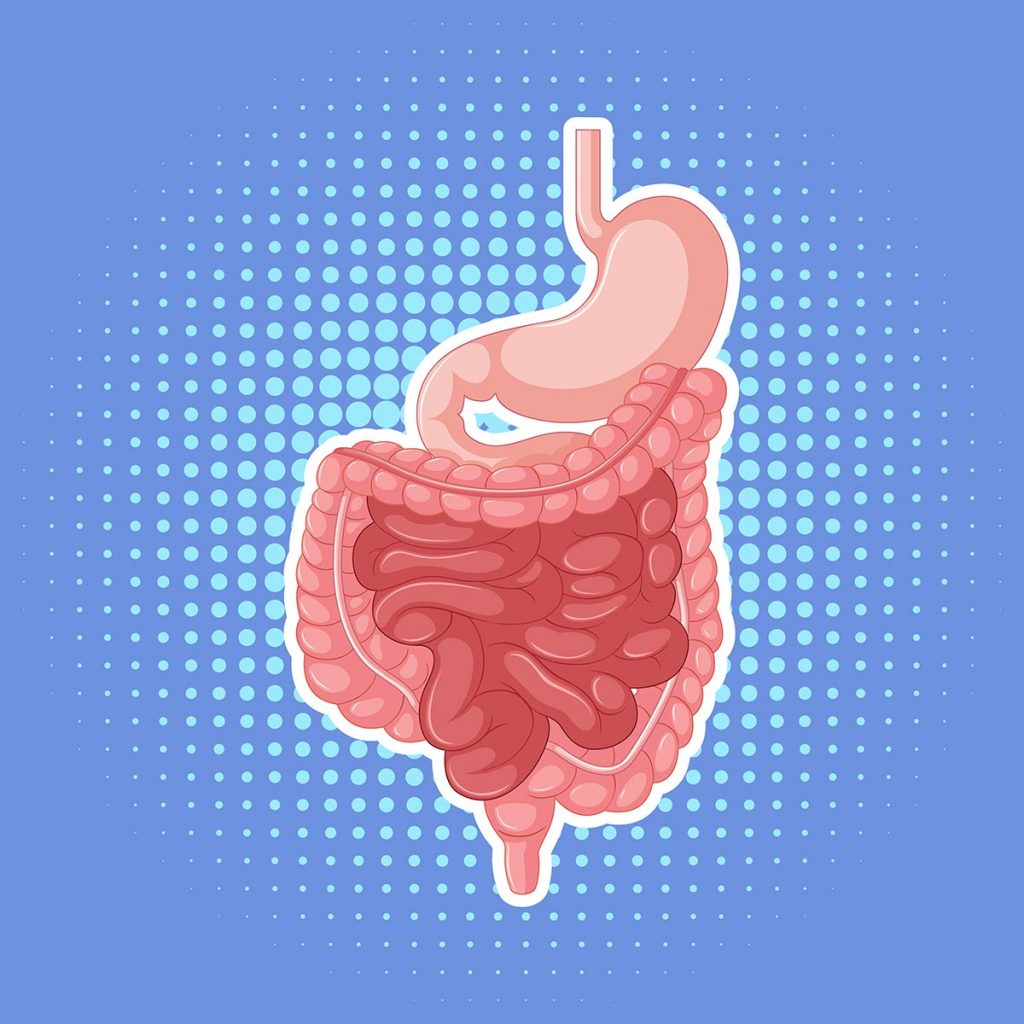
- Gut-Brain Communication
- The Gut and Pain Connection
- Chronic Pain and the Gut
- Painful Conditions Connected to Gut Health
- Managing Gut Health
Medical researchers are rapidly learning more about the relationship between gut health and chronic pain, and the findings are surprising and exciting at the same time. There is a gut-brain axis in which communication flows two ways between the gut and brain. Researchers are learning that gut microbiota is a major factor influencing the communication axis which includes the brain, gut, glands, immune cells and intestinal microbiota.
The following sections discuss the gut-brain connection and how dysregulation is connected to chronic pain.
Gut-Brain Communication
The gut is the gastrointestinal tract which is called the digestive system. In a healthy digestive system in balance, the esophagus, stomach and intestines function together to process food. The gut-brain axis is the communication system in which signals are sent from the digestive system to the brain which controls feelings of pain.

The digestive system has what is called the enteric nervous system (ENS). It is two very thin layers of at least 100 million nerve cells lining all the digestive system’s components. The ENS communicates with the brain. A fairly recent discovery is that the communication along the gut-brain axis is bi-directional, meaning it goes in two directions. The brain communicates with the gut, and the gut sends signals to the brain.
The intestines have trillions of microorganisms (bacteria) living in the intestinal tract. The bacteria are essential to digestion and the absorption of nutrients into the bloodstream, and they influence your body weight, metabolism and immune system. The gut microbiome is specific to each person. Your microbiome is unique. The best balance of microbiota or microorganisms in your gastrointestinal system is not like anyone else’s ideal balance. The gut has the largest microbe population in the body, an indication of the importance of maintaining a healthy microbiome.
The Gut and Pain Connection
The gut microbiome can get imbalanced (dysbiosis) through things like stress, being overweight or obese, medications and a poor diet. The gut lining is particularly sensitive to a diet high in processed foods, artificial sweeteners and emulsifiers (used heavily in processed foods). When the microbiome is not balanced, serious problems can arise. For example, an out-of-balance microbiome can lead to chronic inflammatory diseases.
When the microbiome is disrupted, the communication between the gut and brain is disrupted. Recent research has found that gut microbiota plays a role in several types of chronic pain. There are signaling molecules that come from gut microbiota, including neurotransmitters and neuromodulators, that regulate peripheral and central nervous system sensitization. When the signals are disrupted, chronic pain may develop.
Chronic Pain and the Gut
Living with chronic pain will significantly lower the quality of life. Though the actual biology of pain is still not fully understood, it is known that nociceptors are key to feelings of pain. Nociceptors are the nerve endings that initiate pain sensations. They send signals to the brain and spinal cord when the body is damaged in some manner. They convert things like a physical injury or inflammation into nerve impulses that are transmitted to the spinal cord and then the brain. The brain sends signals back that influence the processing of the pain.
Numerous studies have found that the state of microbiota in the gut is connected to chronic pain in a variety of health conditions. The central nervous system has microglia which respond to CNS signals and signals from the gastrointestinal tract. The communication between the gut microbiome and microglia is involved in chronic pain.
Painful Conditions Connected to Gut Health
Following is a summary of some of the various research findings on the relationship between gut health and chronic pain.
1. Fibromyalgia
Fibromyalgia
Fibromyalgia is a condition characterized by chronic, widespread pain and tenderness in several areas of the body…
Fibromyalgia is a medical condition in which a person experiences widespread musculoskeletal pain. Fibromyalgia and gut health seem to be related. Researchers demonstrated the microbiome in people with chronic musculoskeletal pain, like that associated with fibromyalgia, has reduced diversity.
Fibromyalgia leaky gut is also being researched. A Canadian research team found that alterations in gut bacteria are found in fibromyalgia patients. The bacteria were either more or less compared to people without fibromyalgia.
Leaky gut syndrome is increased intestinal permeability, meaning the gut lining has been damaged. As a result, bacteria, gluten and undigested food particles can get into your system. The causes of leaky gut syndrome include dysbiosis (bacterial imbalance) and poor diet.
2. Joint Pain and/or Muscle Pain
Gut health and joint pain are related also. For example, osteoarthritis causes chronic pain. Various studies have found an association between the gut microbiome and pain and now indicate that diets with high fat, high sugar content and low fiber, along with a lack of exercise, make it more likely you will experience low-grade inflammation. When gut microbiota is in dysbiosis over time, it leaks microorganisms into the circulatory system. This seems to play a role in the documented connection of intestinal inflammation in osteoarthritis.
3. Stomach Pain
Many people suffer from stomach pain which is often also accompanied by symptoms like heartburn, bloating, constipation and/or diarrhea. Chronic pain and other symptoms indicate an imbalanced microbiome. Your stomach is having digestion difficulties because the right balance of microbiota is essential to good digestion.
4. Back Pain
A spinal cord injury causes chronic pain in 60-80 percent of people. Studies have found that in many cases the gut microbiome is in a state of imbalance (gut dysbiosis) which causes immune cell activation and increased production of inflammation mediators.
5. Headaches and Migraines
There appears to be a relationship between gut health and migraines and general headaches. Though more research is underway, studies indicate the gut microbiota, stress hormones, inflammatory mediators and serotonin and neuropeptide pathways have an impact on the bidirectional relationship between the brain and the gut. Data shows that people with a long history of headaches have a higher chance of developing IBS.

6. Arthritis Pain
Arthritis pain is mostly due to inflammation. When the microbiota in the gut is not balanced, research has found that some of the pain mediators are negatively impacted.
7. Autoimmune Diseases
As mentioned, there is an immune system and gut connection. Research evidence is showing the state of gastrointestinal microbiota may be connected to a variety of inflammatory diseases because it affects the immune response. Chronic pain accompanies painful diseases like celiac disease and Crohn’s disease, irritable bowel syndrome and ulcerative colitis.
8. Back Pain in Overweight People
There is also research indicating the back pain that overweight and obese people frequently experience is exacerbated by changes in intestinal microbiota. Once again, it is because the inflammatory and immune responses are affected due to changes in the microbiome composition.
Managing Gut Health
The gut microbiota must be balanced to maintain good health. When not in balance, a variety of diseases can develop. Current research indicates that gut microbiota helps regulate chronic pain that includes inflammatory pain, headaches and pain from injury or disease of the skin, muscles and other parts of the body.
Unhealthy diets play a big role in the state of the microbiome. To manage gut health and promote gut bacteria diversity, eat a healthy diet consisting of high fiber foods like legumes, fruits and vegetables, fermented foods like yogurt and kefir and whole grains. The focus is on eating foods that are mostly plant-based. You should also get regular exercise.
Sources
- https://www.ncbi.nlm.nih.gov/pmc/articles/PMC6469458/
- https://www.ncbi.nlm.nih.gov/pmc/articles/PMC3426293/
- https://pubmed.ncbi.nlm.nih.gov/25731162/
- https://www.bjanaesthesia.org/article/S0007-0912(19)30638-5/fulltext
- https://www.ncbi.nlm.nih.gov/pmc/articles/PMC7016021/
- https://pubmed.ncbi.nlm.nih.gov/33331911/
- Minerbi, A., Gonzalez, E., Brereton, N. J. B., Anjarkouchian, A., Dewar, K., Fitzcharles, M.-A., … Shir, Y. (2019). Altered microbiome composition in individuals with fibromyalgia. PAIN, Articles in Press. https://doi.org/10.1097/j.pain.0000000000001640
- https://www.ncbi.nlm.nih.gov/pmc/articles/PMC7996179/
- https://www.ncbi.nlm.nih.gov/pmc/articles/PMC7779861/
- https://thejournalofheadacheandpain.biomedcentral.com/articles/10.1186/s10194-020-1078-9
- https://www.ncbi.nlm.nih.gov/pmc/articles/PMC3448089/
- https://www.frontiersin.org/articles/10.3389/fendo.2020.00605/full
- https://www.healthline.com/nutrition/improve-gut-bacteria
